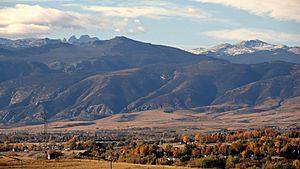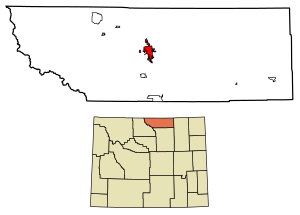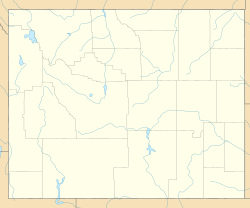Sheridan, Wyoming facts for kids
Quick facts for kids
Sheridan, Wyoming
|
|
|---|---|
|
City
|
|

Sheridan looking west towards the Bighorn Mountains
|
|

Location of Sheridan in Sheridan County, Wyoming.
|
|
| Country | |
| State | |
| County | |
| Area | |
| • Total | 12.71 sq mi (32.91 km2) |
| • Land | 12.68 sq mi (32.85 km2) |
| • Water | 0.02 sq mi (0.06 km2) |
| Elevation | 3,744 ft (1,141 m) |
| Population
(2020)
|
|
| • Total | 18,737 |
| • Density | 1,414.38/sq mi (546.11/km2) |
| Time zone | UTC−7 (Mountain (MST)) |
| • Summer (DST) | UTC−6 (MDT) |
| ZIP code |
82801
|
| Area code(s) | 307 |
| FIPS code | 56-69845 |
| GNIS feature ID | 1594251 |
Sheridan is a city in the state of Wyoming, in the United States. It is the main town of Sheridan County. Sheridan is located about halfway between Yellowstone Park and Mount Rushmore. You can reach it using U.S. Route 14 and 16. In 2020, about 18,737 people lived there. This makes it the 6th largest city in Wyoming.
Contents
History of Sheridan
How Sheridan Got Its Name
The city of Sheridan was named after General Philip Sheridan. He was a brave leader of the Union cavalry during the American Civil War. Before the city was built, many battles happened in this area. US Cavalry fought against Native American tribes like the Sioux and Cheyenne.
Early Settlers and Growth
In 1878, a trapper named George Mandel built the first cabin on Big Goose Creek. You can still see a rebuilt version of this cabin today. In 1882, John Loucks, who became the first mayor, had the townsite surveyed. He had served under General Sheridan.
At first, the nearby town of Big Horn was larger. But in 1888, Sheridan County was formed. Voters chose Sheridan as the county seat. This meant it became the main town for the county.
The Railroad Arrives
A big change for Sheridan happened in 1892. The Burlington and Missouri Railroad arrived. This helped Sheridan's economy grow a lot. The famous Sheridan Inn was built, and even Buffalo Bill Cody was involved with it. Railroad jobs, like maintaining tracks and treating wood for ties, were very important. The railroad also helped local businesses and allowed raw materials to be sent out. This made Sheridan a key place for sending goods to bigger cities like Chicago. For the next 20 years, the city grew quickly.
Coal Mining and New People
In the 1890s, many coal mines opened north of Sheridan. Investors from Chicago helped fund these mines. This brought many new people to the area. Immigrants from Poland, Italy, Greece, Germany, Mexico, and Japan came to work in the mines, on the railroad, or in farming. Many Polish families came from the village of Jaworzynka. English immigrants mostly became farmers.
One well-known immigrant was Zarif Khan. He was from Afghanistan (which is now Pakistan). He sold tamales and hamburgers and was known for being very kind.
Farming and the Economy
Farming was also a huge part of Sheridan's early economy. By the 1920s, Sheridan was a center for processing farm products. These included wheat, dairy, and sugar beets. There was also a stockyard for shipping cattle by train.
In the 1950s, underground coal mining became less important. This was because trains started using diesel instead of steam. Many miners moved into Sheridan and found new jobs. The economy grew again in the 1970s with new strip mines. Many new neighborhoods were built as farming changed.
Tourism and Modern Sheridan
Tourism has always been important to Sheridan. Many guest ranches, like Eaton's Ranch, welcomed visitors who arrived by train. Some guests even moved to Sheridan permanently. They helped shape the area's economy and culture. Sheridan now has many local foundations and non-profit groups. These include a large Y.M.C.A. and the WYO Theater.
Today, Sheridan is a major economic hub for a large area. Its economy is diverse, meaning it has many different types of jobs. These include government, healthcare, education, and manufacturing. This is different from many other Wyoming towns that rely mostly on natural resources.
Geography and Climate
Where is Sheridan Located?
Sheridan covers an area of about 10.95 square miles (28.36 square kilometers). Most of this area is land, with a small amount of water.
What is Sheridan's Climate Like?
Sheridan has a semi-arid climate. This means it's quite dry. Winters are cold and dry. Summers are hot, and they used to be wet, but recently they have been drier.
| Climate data for Sheridan, Wyoming (Sheridan County Airport) (1991–2020 normals, extremes 1907–present) | |||||||||||||
|---|---|---|---|---|---|---|---|---|---|---|---|---|---|
| Month | Jan | Feb | Mar | Apr | May | Jun | Jul | Aug | Sep | Oct | Nov | Dec | Year |
| Record high °F (°C) | 71 (22) |
76 (24) |
80 (27) |
87 (31) |
95 (35) |
107 (42) |
107 (42) |
106 (41) |
104 (40) |
93 (34) |
81 (27) |
77 (25) |
107 (42) |
| Mean maximum °F (°C) | 59.3 (15.2) |
58.6 (14.8) |
71.0 (21.7) |
78.9 (26.1) |
85.2 (29.6) |
94.1 (34.5) |
100.7 (38.2) |
99.5 (37.5) |
94.8 (34.9) |
83.1 (28.4) |
70.2 (21.2) |
60.1 (15.6) |
101.9 (38.8) |
| Mean daily maximum °F (°C) | 36.3 (2.4) |
38.4 (3.6) |
49.0 (9.4) |
56.7 (13.7) |
66.1 (18.9) |
76.9 (24.9) |
87.8 (31.0) |
86.6 (30.3) |
75.6 (24.2) |
59.9 (15.5) |
46.7 (8.2) |
36.7 (2.6) |
59.7 (15.4) |
| Daily mean °F (°C) | 24.0 (−4.4) |
26.0 (−3.3) |
35.7 (2.1) |
43.2 (6.2) |
52.4 (11.3) |
61.8 (16.6) |
70.7 (21.5) |
69.1 (20.6) |
59.1 (15.1) |
45.4 (7.4) |
33.3 (0.7) |
24.5 (−4.2) |
45.4 (7.5) |
| Mean daily minimum °F (°C) | 11.7 (−11.3) |
13.7 (−10.2) |
22.4 (−5.3) |
29.7 (−1.3) |
38.7 (3.7) |
46.8 (8.2) |
53.5 (11.9) |
51.5 (10.8) |
42.5 (5.8) |
31.0 (−0.6) |
19.9 (−6.7) |
12.2 (−11.0) |
31.1 (−0.5) |
| Mean minimum °F (°C) | −12.9 (−24.9) |
−8.8 (−22.7) |
2.2 (−16.6) |
14.8 (−9.6) |
25.7 (−3.5) |
35.3 (1.8) |
44.4 (6.9) |
40.7 (4.8) |
29.5 (−1.4) |
12.7 (−10.7) |
−2.2 (−19.0) |
−9.1 (−22.8) |
−20.0 (−28.9) |
| Record low °F (°C) | −36 (−38) |
−38 (−39) |
−23 (−31) |
−10 (−23) |
13 (−11) |
27 (−3) |
35 (2) |
26 (−3) |
6 (−14) |
−12 (−24) |
−27 (−33) |
−41 (−41) |
−41 (−41) |
| Average precipitation inches (mm) | 0.61 (15) |
0.65 (17) |
1.02 (26) |
1.87 (47) |
2.68 (68) |
1.98 (50) |
1.07 (27) |
0.71 (18) |
1.47 (37) |
1.57 (40) |
0.76 (19) |
0.54 (14) |
14.93 (378) |
| Average snowfall inches (cm) | 13.0 (33) |
12.3 (31) |
11.0 (28) |
8.5 (22) |
1.0 (2.5) |
0.0 (0.0) |
0.0 (0.0) |
0.0 (0.0) |
0.8 (2.0) |
6.7 (17) |
8.1 (21) |
10.0 (25) |
71.4 (181) |
| Average precipitation days (≥ 0.01 in) | 7.5 | 8.1 | 9.7 | 10.8 | 12.3 | 10.2 | 7.6 | 6.3 | 6.6 | 8.8 | 7.3 | 7.1 | 102.3 |
| Average snowy days (≥ 0.1 in) | 7.3 | 8.5 | 6.3 | 4.3 | 0.7 | 0.0 | 0.0 | 0.0 | 0.3 | 2.8 | 5.2 | 7.6 | 43.0 |
| Average relative humidity (%) | 66.1 | 66.3 | 62.7 | 58.4 | 60.3 | 59.7 | 50.2 | 47.1 | 54.4 | 57.7 | 65.6 | 66.7 | 59.6 |
| Mean monthly sunshine hours | 155.2 | 172.1 | 228.0 | 242.8 | 279.3 | 313.1 | 350.9 | 322.9 | 255.8 | 205.5 | 148.2 | 148.8 | 2,822.6 |
| Percent possible sunshine | 54 | 59 | 62 | 60 | 61 | 67 | 75 | 74 | 68 | 60 | 51 | 54 | 63 |
| Source 1: NOAA (relative humidity and sun 1961–1990) | |||||||||||||
| Source 2: NOAA | |||||||||||||
People Living in Sheridan
| Historical population | |||
|---|---|---|---|
| Census | Pop. | %± | |
| 1890 | 281 | — | |
| 1900 | 1,559 | 454.8% | |
| 1910 | 8,408 | 439.3% | |
| 1920 | 9,175 | 9.1% | |
| 1930 | 8,538 | −6.9% | |
| 1940 | 10,529 | 23.3% | |
| 1950 | 11,500 | 9.2% | |
| 1960 | 11,651 | 1.3% | |
| 1970 | 10,856 | −6.8% | |
| 1980 | 15,146 | 39.5% | |
| 1990 | 13,900 | −8.2% | |
| 2000 | 15,804 | 13.7% | |
| 2010 | 17,444 | 10.4% | |
| 2020 | 18,737 | 7.4% | |
Sheridan's Population in 2010
In 2010, there were 17,444 people living in Sheridan. There were 7,680 households, which are groups of people living together. About 4,296 of these were families.
Most people (94.9%) were White. There were also smaller groups of African American, Native American, and Asian people. About 4.3% of the population was Hispanic or Latino.
The average age in the city was 39.2 years old. About 22% of residents were under 18. About 15.8% were 65 or older. The number of males and females was almost equal.
What Does Sheridan's Economy Look Like?
Jobs and Industries in Sheridan
In the past, Sheridan's main jobs included cattle ranching, logging, and coal mining. People also worked on the railroad and in farming. There were small factories like a flour mill and a brewery.
Today, people in Sheridan work in many different fields. These include coal mines, schools, healthcare, and retail. Many also work in banking, law, government, and construction. Farming and ranching are still important jobs too.
Why is Tourism Important to Sheridan?
Sheridan is a popular place for vacations. It was even ranked as a top Western town by True West Magazine. Its location near Interstate 90 and U.S. Route 14 makes it an easy stop for travelers.
Arts and Culture in Sheridan
Rodeo and Western Traditions
Sheridan has a strong rodeo culture. This comes from its history of ranching and its love for Wild West entertainment. The Sheridan WYO Rodeo started in 1931. It is now known as one of the best rodeos in the country. About 25,000 guests come to this week-long event every July.
In 1953, the Miss Indian America Pageant began. This event celebrated American Indian culture. Today, Sheridan's summer celebrations still combine cowboy and American Indian traditions. This mix inspired the Walt Longmire mystery novels and TV series. The author, Craig Johnson, lives nearby.
Famous Landmarks and Museums
Many important places in Sheridan are listed on the National Register of Historic Places. These include:
- Trail End State Historic Site - This was the home of John B. Kendrick. He was a cattle rancher who became the governor of Wyoming and a U.S. Senator. The mansion is now a museum.
- Quarter Circle A Ranch - Located near Big Horn, this ranch is home to The Brinton Museum. It has a great collection of Western and American Indian art.
- Sheridan County Courthouse (Wyoming) - The main building for the county government.
- Fort Mackenzie - Now a hospital for veterans.
- Holy Name Catholic School - The oldest Catholic school building in Wyoming.
- St. Peter's Episcopal Church - Known for its beautiful architecture and stained glass.
- The historic Sheridan Inn (1893) - Many famous guests have stayed here.
- Sheridan Main Street Historic District - A historic area with many old buildings.
- Sheridan Flouring Mills, Inc. - An old flour mill with a tall smokestack.
Sheridan also has other museums. The Sheridan County Museum tells the story of the area. King's Saddlery Museum shows Western leather work and history. The Brinton Museum has art by famous artists like Charles M. Russell.
Parks and Recreation
The City of Sheridan has nine parks. Kendrick Park is a popular spot. It has a playground for kids and a seasonal ice cream shop. You can also see buffalo and elk there.
Education in Sheridan
Schools for All Ages
Public schools in Sheridan are part of Sheridan County School District #2. There are six elementary schools and two junior high schools. There are also two high schools: Sheridan High School and Ft. Mackenzie High School.
For older students, Sheridan College offers higher education. Sheridan also has a public library, which is part of the Sheridan County Public Library System.
Media in Sheridan
Radio Stations
You can listen to many radio stations in Sheridan:
- KROE AM 930
- KWYO AM 1410
- KHRW FM 92.7
- KYTI FM 93.7
- KZWY FM 94.9
- KLGT FM 96.5
- KZZS FM 98.3
- KOWY FM 102.3
- KLQQ FM 104.9
Two of these, KSUW FM 91.3 and KPRQ FM 88.1, are public radio stations.
Television Channels
Five television channels are available in Sheridan:
- KTVQ (CBS) from Billings, Montana
- KSWY (NBC) from Casper, Wyoming
- KSGW-TV (ABC) which shows programs from KOTA-TV in Rapid City, South Dakota
- A translator for PBS channel KCWC-DT from Lander, Wyoming
- A translator for KTWO (ABC) from Casper
Local Newspapers
The local newspaper in Sheridan is The Sheridan Press. You can also read regional newspapers like The Billings Gazette and Casper Star Tribune.
Transportation
Getting Around Sheridan
You can travel to Sheridan by bus using Jefferson Lines. Once in town, Goose Creek Transit provides local bus service. The Sheridan Trolley runs from Memorial Day to Labor Day.
Sheridan is also served by Sheridan County Airport. It offers flights to Denver, Colorado through United Express. Bighorn Airways provides air charter services and aircraft repair.
Notable People from Sheridan
- James B. Aleshire - A major general in the U.S. Army.
- Brad Anderson - Former CEO of Best Buy.
- Jerry Andrus - A famous magician and illusionist.
- Jim Benepe - A professional golfer.
- Buffalo Bill Cody - Auditioned performers for his Wild West Show at the Sheridan Inn.
- William Henry Harrison III - A U.S. Representative from Wyoming.
- John B. Kendrick - Governor of Wyoming and U.S. Senator.
- Zarif Khan - A well-known restaurant owner and investor in Sheridan.
- T. Allen Lawson - An American artist.
- Forrest Edward Mars Jr - Heir to the Mars candy company.
- Clint Oldenburg - Played football for the Washington Redskins.
- Romaine Patterson - A radio host and activist.
- John Pilch - A former NBA basketball player.
- John Howard Pyle - Governor of Arizona.
- Pete Simpson - A state representative and university administrator.
- Oliver Wallop, 8th Earl of Portsmouth - A state legislator and rancher.
- Cris Williamson - A singer and songwriter.
- Dan M. "Buck" Brannaman - A famous horse trainer.
- Constantine Scollen - A missionary priest who served in Sheridan.
Images for kids
See also
 In Spanish: Sheridan (Wyoming) para niños
In Spanish: Sheridan (Wyoming) para niños




